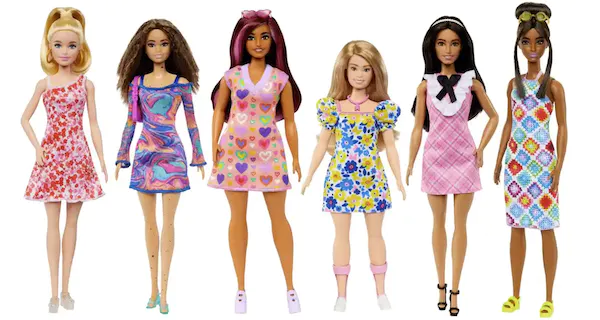Four women with Down syndrome share their thoughts on Mattel’s new Barbie

Image: The 2023 Fashionistas line up of Barbies
Can Barbie successfully balance idealism with authenticity? Tristan Sinclair, a program manager at Melbourne’s Inclusion Foundation, puts this question to some of their friends with Down syndrome.
Mattel has launched a Barbie with Down syndrome – and raised some questions. What happens when a symbol of fantasy and idealism, like Barbie, ventures into the realm of realistic representation and inclusivity? Can a Barbie with Down syndrome balance the brand’s fantastical origins with the authentic portrayal of an underrepresented community?
I recently spoke with some of my friends with Down syndrome, Tara (14), Alle (20), Emily (30), and Shea (37), about the new Barbie with Down syndrome, as I was surprised to not have seen voices from their community responding to this in the media.
As Shea pointed out, “we are the experts in our own lives”. Emily added that “it’s really important that people with Down syndrome are seen… we enhance the lives of the people around us, it’s important we are put at the front to lead”. 
Image: Emily
Inspired by this idea, I decided to explore their thoughts about the new doll.
When looking at the 2023 Fashionistas line up of Barbies, at a glance, Emily confessed she had “no idea” which Barbie has Down syndrome – a unanimously shared experience. After a second, closer inspection, all agreed on which one she was. Alle summarised: “she’s the only one who looks different”.
Image: Alle
Emily noted that this Barbie did have “shorter legs, I think her face looks a bit like she has Down syndrome”. Alle expressed that “it would be better to have more Barbies with Down syndrome, with different colour skin and hair… some friends with Down syndrome might feel left out”. Shea mentioned the importance of representing different ways of having Down syndrome, such as those with alopecia.
There was consensus that having only one variation of a Barbie with Down syndrome could exclude individuals within the Down syndrome community, and those who know them, who don’t feel represented. This could lead to questioning why their representation isn’t considered worthy or desirable.
Image: Tara
Our discussion turned to whether Barbie looked like she had Down syndrome ‘enough’. Tara didn’t really mind, explaining that to her, “people can look the same if they have Down syndrome or not. She added, “it’s cool to see a Barbie who looks a bit like me”. Although, if she still played with Barbies, she wouldn’t mind which one.
According to Alle, people who think the doll doesn’t look like she has Down syndrome ‘enough’ are wrong, because “everyone with Down syndrome looks different, but she looks like a Barbie with Down syndrome”. Shea agreed that “clearly this Barbie has Down syndrome. I think other people don’t really get to judge if she’s ‘enough’ or not. I think people should accept who she is, she doesn’t have to look like anyone else”. 
Image: Shea
When Barbie tries to achieve both a realistic representation of an identity, such as Down syndrome, and maintain its iconic Barbie aesthetic, there’s potential for confusion. The crux of the issue lies in the inherent tension between the idealised and relatively homogeneous nature of the Barbie brand, and the authentic representation of diverse identities.
These collective perspectives underscore the significance of inclusive representation on the appearances of people with Down syndrome. When it comes to Barbie with Down syndrome, Emily shared a sentiment all agreed on: “it is important for little kids, and adults, to have role models with Down syndrome. Not just kids with Down syndrome, but everyone, because we are a part of people’s lives.”
Tristan Sinclair is an ally to people with intellectual disability and has found a great sense of belonging and meaning in their vocation. They now like to share their own experiences, and those of the people they support, through speaking and writing opportunities. Tristan also runs programs to support people with intellectual disabilities to become artists, advocates and teachers.






